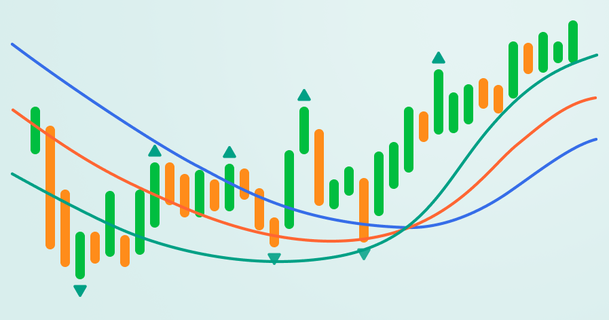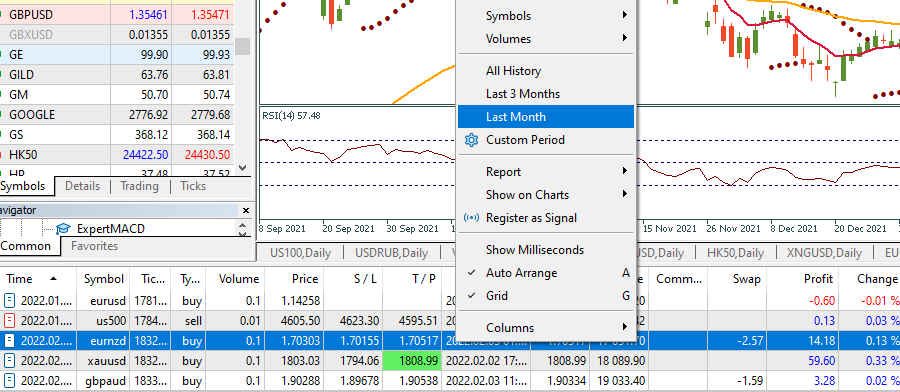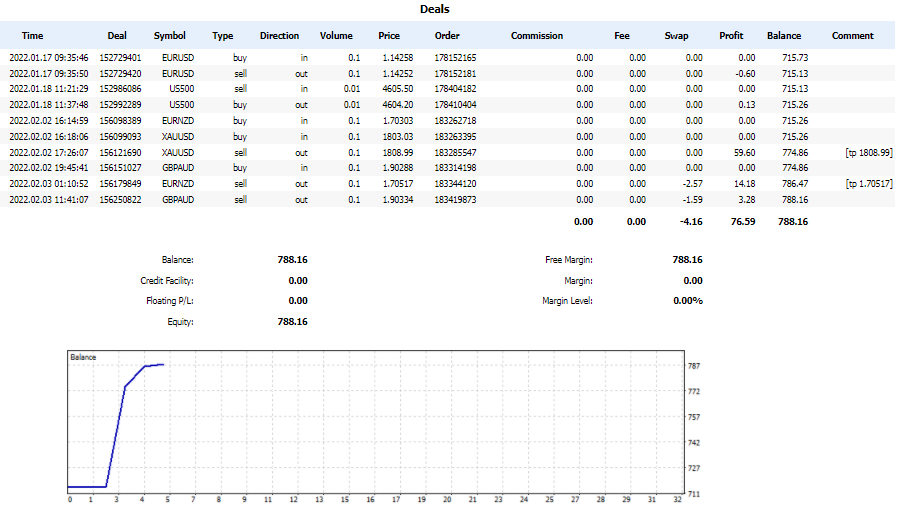
Bill Williams é o criador de alguns dos indicadores de mercado mais populares: Awesome Oscillator, Fractals, Alligator e Gator.

Não perca seu tempo. Acompanhe o impacto das NFP no dólar dos EUA!
Aviso de coleta de dados
Nós mantemos um registo dos seus dados para fazer funcionar este sítio web. Ao clicar no botão, concorda com a nossa Política de Privacidade.

Livro de Forex para principiantes
O seu grande guia no mundo do trading.
Confira a sua caixa de entrada!
Encontrará no nosso e-mail o Livro Básico de Forex. Basta tocar no botão para obtê-lo!
Alerta de risco: ᏟᖴᎠs são instrumentos complexos e vêm com um alto risco de perda rápida do dinheiro devido à alavancagem.
68,53% das contas de investidores de retalho perdem dinheiro ao negociar ᏟᖴᎠs com este provedor.
Deve considerar se entende como funcionam os ᏟᖴᎠs e se tem condições de assumir o alto risco de perder o seu dinheiro.
2022-08-26 • Atualizado
Informação não é consultoria em investimentos
Todo trader busca os melhores resultados. Porém, só um trader inteligente entende a importância de analisar o desempenho em suas operações diárias. Imagine poder abrir operações aleatoriamente e até lucrar em algumas delas, mas acabar ficando perdido por não ter bons dados. Analisar o desempenho das suas operações é necessário sobretudo quando você está testando ou formulando um novo sistema de negociação. Este artigo vai falar dos medidores primários de desempenho no trading, que avaliam as suas jogadas no mercado e ajudam a criar a abordagem perfeita no trading.
Como você já deve ter deduzido pela introdução, desempenho no trading implica em ter um método de avaliação dos resultados do trader. O trader pode usar diferentes medidores para fazer uma boa avaliação e chegar a uma conclusão relevante.
O exemplo mais simples de medidor é o retorno sobre capital (ROC), calculado como o valor do lucro dividido pelo capital investido. Se, por exemplo, você deposita US$ 1.000 e lucra US$ 200 em determinado intervalo, seu retorno é de 20%.
Além do retorno, há outros medidores que você pode usar para avaliar os resultados das suas operações. Discutiremos a seguir as técnicas mais conhecidas para fazer isso.
Existem diferentes formas de acompanhar o seu desempenho no trading. Alguns traders, por exemplo, usam o Microsoft Excel, no qual listam seus depósitos, tamanho de lote por ordem, spread, Take Profit e Stop Loss. Com base nesses dados, eles calculam automaticamente os medidores primários para avaliar o desempenho, como lucro/prejuízo médio, meta de preço etc. Se você opera no MetaTrader 4 ou 5, é possível usar os recursos que o próprio software oferece.
Gerando relatórios de desempenho no MT
Caso queira consultar o seu desempenho no trading pelo MetaTrader, acesse a Caixa de Ferramentas e abra o Histórico.

Primeiro você deve dar um clique com o botão direito na tabela e escolher o período que deseja analisar.

Nós escolhemos um mês. Depois, clique em Relatório e salve o arquivo no formato HTML ou XML. Se você salvar no formato HTML, poderá utilizar qualquer navegador web para abrir o arquivo.

O MetaTrader vai gerar um relatório como este:

Abaixo do gráfico, o MetaTrader fornece alguns dados interessantes sobre as operações.

Vamos descobrir o significado de todos esses medidores!
Vamos começar entendendo a diferença entre lucro bruto e lucro líquido. Lucro bruto é o lucro antes do desconto de despesas ou custos. Lucro líquido é esse lucro depois de descontados todos os custos. Em Forex, os custos podem ser cobranças de swap e comissões pagas à corretora.
O fator lucro mostra quanto dinheiro você ganha em comparação com quanto dinheiro que perde. No caso acima, por exemplo, tivemos cinco operações e lucramos em quatro delas os seguintes valores: US$ 0,13; US$ 14,18; US$ 59,6; e US$ 3,28. Por outro lado, perdemos US$ 0,60 em uma operação. Se dividirmos o valor total das posições rentáveis, descontados os swaps, pelo valor total das posições perdedoras, obtemos:
((0,13 + 14,18 + 59,6 + 3,28) - 4,16) / 0,6 = 121,72
Isso significa que, nesse caso, o lucro foi 121,7 vezes o prejuízo. Trata-se de um número extremamente alto. Observe que, ao testar uma estratégia, é fortemente recomendado que o fator lucro fique entre 1,75 e 4. Caso contrário, a estratégia não é confiável.
Drawdown absoluto é a diferença entre o depósito inicial e o ponto mais baixo atingido pela conta de negociação abaixo do nível do depósito. Exemplo: se você deposita US$ 1.000, sua conta chega ao pico de US$ 2.000 e então cai para US$ 800, o drawdown absoluto é de US$ 200 (US$ 1.000 - US$ 800 = US$ 200). Este valor representa o seu maior prejuízo em comparação com o depósito inicial.
Drawdown máximo é a diferença entre o valor mais alto e o valor mais baixo atingidos pela sua conta. No exemplo dado na definição de drawdown absoluto, o drawdown máximo seria de US$ 2.000 - US$ 800 = US$ 1.200.
Drawdown relativo é a queda máxima do seu capital, em porcentagem. Pode ser calculado como o drawdown máximo dividido pelo valor máximo do capital e multiplicado por 100%. No nosso caso, o drawdown relativo seria igual a 60%.
Todos os três medidores são fundamentais para o trader, pois eles ajudam a identificar o fator de risco da conta de negociação. A qualidade do drawdown depende do tamanho da conta de negociação. Se a sua conta é grande, o normal é 5–6%, mantido sempre abaixo de 6%. Se a sua conta é pequena, então 15–20% de drawdown é normal, ao passo que um drawdown acima de 20% pode ser considerado como arriscado.
Com base no cálculo do drawdown podemos identificar o nosso fator de recuperação. O fator de recuperação equivale ao valor absoluto do lucro líquido, dividido pelo drawdown máximo. Exemplo: se temos lucro líquido de 72,43 e drawdown máximo de 0,6; nosso fator de recuperação é:
72,43 / 0,6 = 120,72.
O fator de recuperação geralmente deve ser maior que 1. De acordo com os traders, quanto maior o fator de recuperação, mais rápido a operação se recupera de um drawdown.
Outro indicador interessante que consta no relatório é o Índice de Sharpe (ou relação de Sharpe), desenvolvido por William F. Sharpe, ganhador do prêmio Nobel. Esse índice ajuda o investidor a entender o retorno do investimento em comparação com o risco. Quanto maior a relação, maior é o retorno do trader em relação ao risco assumido. Os traders costumam preferir Índice de Sharpe igual ou maior que 1. Quando a relação fica abaixo de 1, o trader está arriscando demais em comparação com o retorno esperado. A fórmula clássica do Índice de Sharpe é esta:
Índice de Sharpe = (rendimento da carteira - taxa livre de risco) / desvio padrão do rendimento excedente da carteira
No MetaTrader, o Índice de Sharpe é calculado como o lucro médio sobre o desvio padrão.
Existem também o Índice de Sortino, bem parecido com o Índice de Sharpe, porém com alguns ajustes. O Índice de Sortino não leva em conta a volatilidade total do investimento. Diferente do Índice de Sharpe, o Índice de Sortino foca na volatilidade de queda. Ele é calculado pela diferença entre o retorno médio do investimento e a taxa livre de riscos. O resultado é dividido pelo desvio padrão dos rendimentos negativos. A preferência é por uma relação alta, que mostra que o trader vai ter maior rendimento com cada unidade de risco de queda.
A terceira relação é o Índice de Calmar, que usa o drawdown como medidor de risco.
Além dos medidores listados no relatório do MetaTrader, há outros que você pode usar para analisar o seu desempenho. Vamos analisá-los em detalhe.
Este não é bem um medidor, e sim uma regra de gestão de riscos. Ao usá-lo, você escolhe uma porcentagem que está disposto a arriscar por operação e não a ultrapassa. Os 2% são o que os traders geralmente escolhem. Assim você impede que suas operações sofram drawdowns inesperados.
Este método foca no número de pontos ou pips que você deseja arriscar por operação. Contudo, os especialistas contraindicam esta abordagem e aconselham focar em uma determinada porcentagem do risco.
Os livros clássicos de Forex costumam recomendar uma relação risco/recompensa de 1:3. Isso significa que o retorno de determinada operação deve ser três vezes maior que o risco.
Esta relação compara o número de operações rentáveis com o número de operações nas quais o trader teve prejuízo. Exemplo: se 6 das suas 10 operações dão lucro, a sua relação lucro/prejuízo é de 60%. Às vezes, traders rentáveis têm uma relação de menos de 50%. Isso é aceitável quando o lucro de suas operações rentáveis supera o prejuízo sofrido com as operações perdedoras.
A leitura deste artigo permite a análise das suas operações no MetaTrader e a interpretação dos medidores aqui citados. Vale ressaltar que esses elementos da análise de desempenho são ideais para o teste de uma estratégia, seja de forma manual ou com o auxílio de um backtester. Se você programa robôs de negociação, a análise do drawdown e dos fatores de lucro são as chaves para compreender eventuais melhorias.

Bill Williams é o criador de alguns dos indicadores de mercado mais populares: Awesome Oscillator, Fractals, Alligator e Gator.

As estratégias de tendência são boas: podem gerar resultados consideravelmente bons em qualquer tempo gráfico e com qualquer ativo. A ideia principal da estratégia ADX é tentar apanhar o arranque da tendência.

As estratégias de contratendência são sempre as mais perigosas, porém as mais lucrativas. Temos o prazer de apresentar uma excelente estratégia de contratendência que funciona em qualquer mercado e com qualquer ativo.
Seu pedido foi aceito
Faremos contacto no intervalo de horário escolhido
O próximo pedido de contato para este número de telefone estará disponível em 00:30:00
Se tiver um problema urgente, por favor, contacte-nos via
Chat ao vivo
Erro interno. Por favor, tente novamente mais tarde